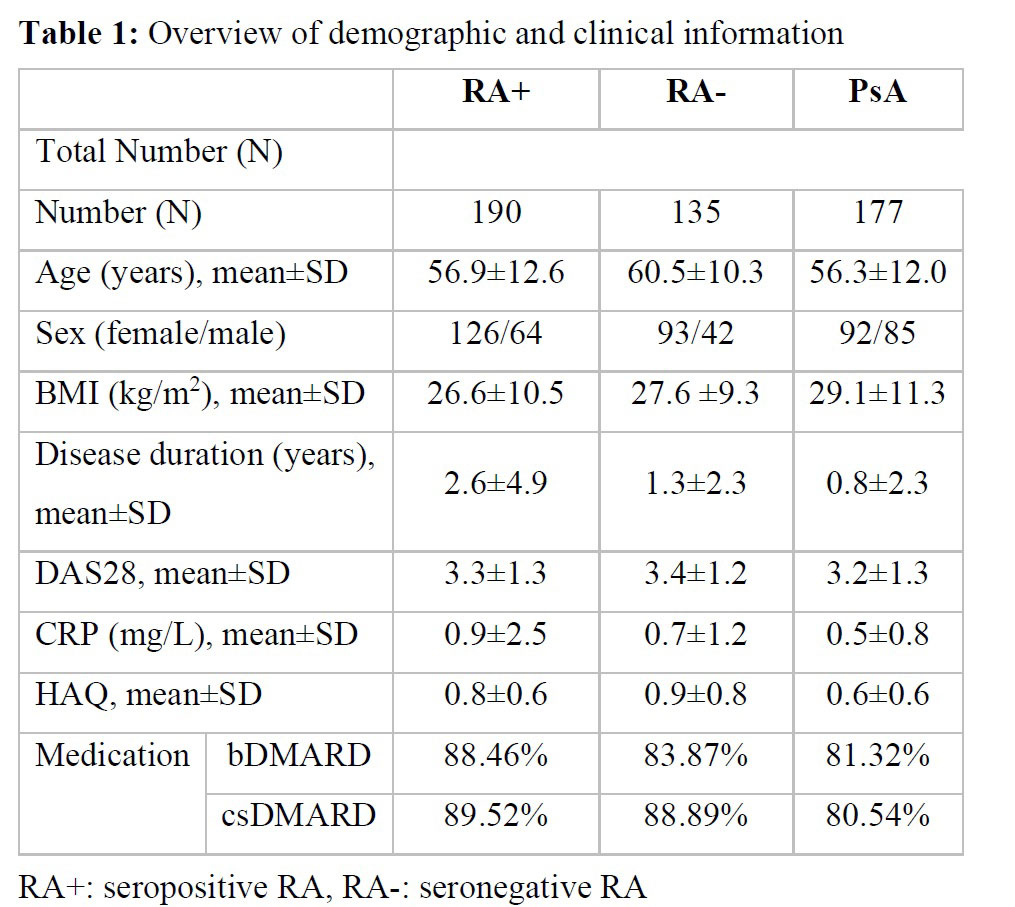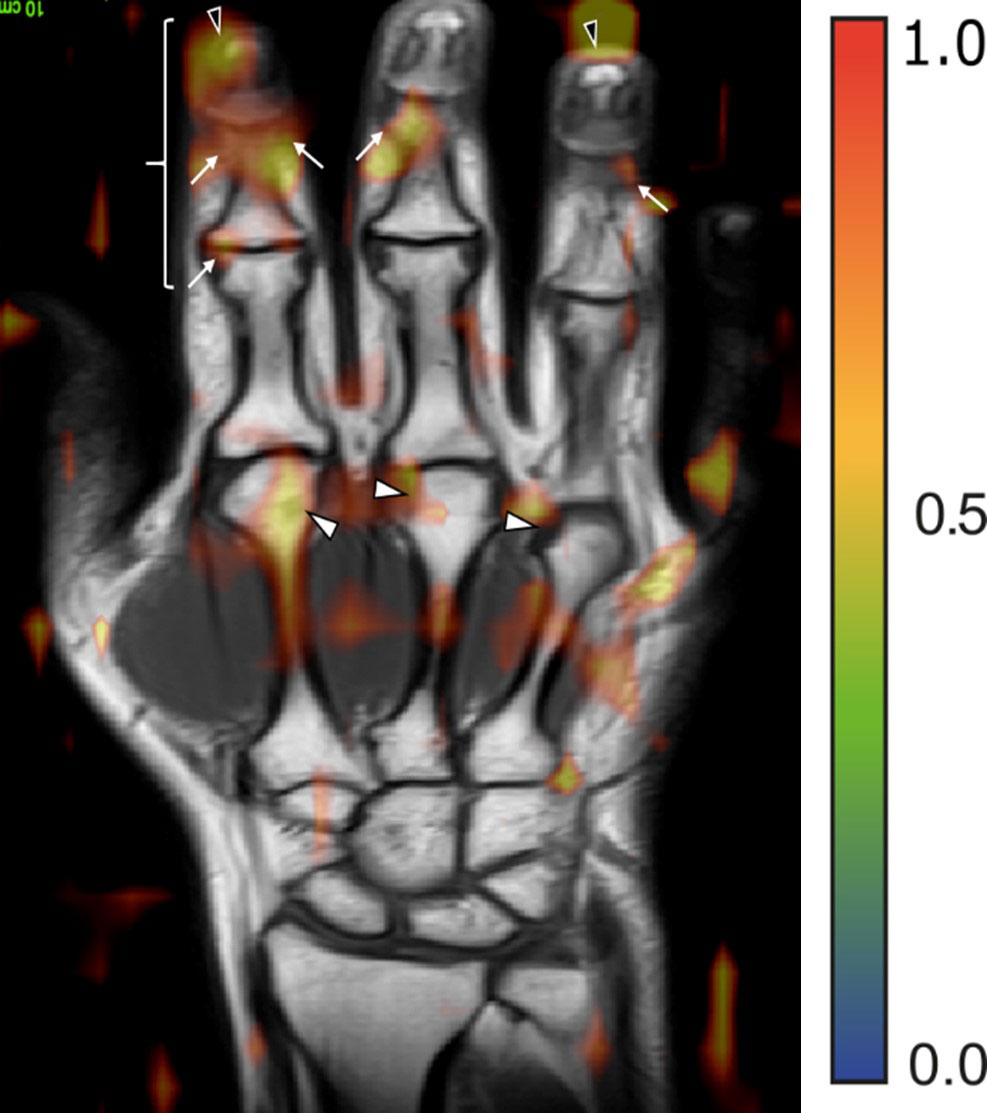Session Information
Session Type: Poster Session A
Session Time: 1:00PM-3:00PM
Background/Purpose: To evaluate (i) whether neural networks can distinguish seropositive rheumatoid arthritis (RA+), seronegative RA (RA-), and psoriatic arthritis (PsA) using MRI data based on the structural inflammation patterns.
Methods: Neural networks based on the ResNet [1] architecture were trained to distinguish (i) RA+ vs. PsA, (ii) RA- vs. PsA and (iii) RA+ vs. RA- using hand MRI data. MR sequences consisted of five different sequences (T1 coronal, T2 coronal, T1 coronal and axial fat suppressed contrast-enhanced (CE), and T2 fat suppressed axial). Two neural network trainings were performed, where (i) the neural network had access only to MR data and (ii) then to MR and clinical and demographic data (Figure 1). Using a specialized visualization technique for the neural networks (occlusion) the regions most important for the network were recorded and correlated to the respective anatomical regions by an experienced rheumatologist [2,3].
Results: The dataset consisted of MRI scans from 502 patients (135 RA-, 190 RA+, 177 PsA) (Table 1). Differentiation between disease entities as measured by the AUROC was 75% (SD 3%) for RA+ vs PsA, 74% (SD 8%) for RA- vs PsA, and 67% (6%) for RA+ vs RA-. All MR sequences were important for neural network performance, but without contrast-enhanced sequences, the difference in performance was marginal. Adding demographic and clinical parameters to MR dada did not improve the performance of the neural network significantly. Interestingly, the regions important for the network were regions, which also had clinical relevance (Figure 2).
Conclusion: Neural networks can help distinguish between different forms of inflammatory arthritis based on MRI inflammatory patterns, apparently focusing on regions of clinical relevance.
References [1] Kensho Hara, Hirokatsu Kataoka, and Yutaka Satoh 2018. Can Spatiotemporal 3D CNNs Retrace the History of 2D CNNs and ImageNet? In Proceedings of the IEEE Conference on Computer Vision and Pattern Recognition (CVPR) (pp. 6546–6555).
[2] Østergaard M, McQueen F, Wiell C, et al. The OMERACT Psoriatic Arthritis Magnetic Resonance Imaging Scoring System (PsAMRIS): Definitions of key pathologies, suggested MRI sequences, and preliminary scoring system for PsA hands. J Rheumatol 2009;36:1816–24. doi:10.3899/jrheum.090352
[3] Østergaard M, Peterfy C, Conaghan P, et al. OMERACT Rheumatoid Arthritis Magnetic Resonance Imaging Studies. Core set of MRI acquisitions, joint pathology definitions, and the OMERACT RA-MRI scoring system. J Rheumatol 2003;30:1385–6.
To cite this abstract in AMA style:
Folle L, Bayat S, Kleyer A, Fagni F, Kapsner L, Schlereth M, Meinderink T, Breininger K, Tascilar K, Kroenke G, Uder M, Sticherling M, Bickelhaupt S, Schett G, Maier A, Roemer F, Simon D. Neural Networks for Distinguishing Rheumatoid Arthritis from Psoriatic Arthritis by Using Magnetic Resonance Imaging [abstract]. Arthritis Rheumatol. 2022; 74 (suppl 9). https://acrabstracts.org/abstract/neural-networks-for-distinguishing-rheumatoid-arthritis-from-psoriatic-arthritis-by-using-magnetic-resonance-imaging/. Accessed .« Back to ACR Convergence 2022
ACR Meeting Abstracts - https://acrabstracts.org/abstract/neural-networks-for-distinguishing-rheumatoid-arthritis-from-psoriatic-arthritis-by-using-magnetic-resonance-imaging/



